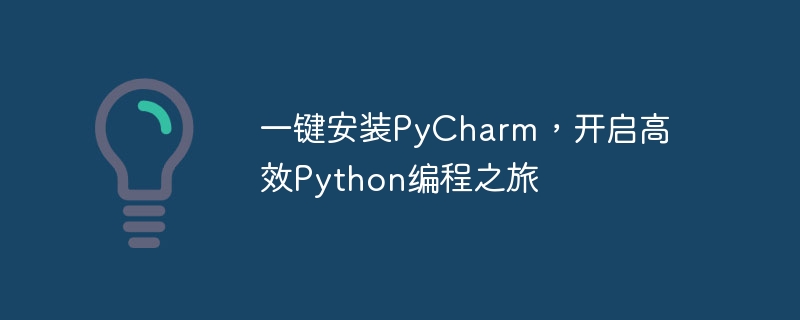

Install PyCharm with one click and start the journey of efficient Python programming. Specific code examples are required
With the popularity of the Python language and the continuous expansion of application scenarios, more and more Many developers choose to use Python for programming work. For Python programming, an easy-to-use and efficient integrated development environment (IDE) is very important. As an IDE specially designed for Python developers, PyCharm has become the first choice of many Python developers with its powerful functions and friendly interface.
The installation and configuration of PyCharm can be said to be very simple. You only need to follow a few simple steps to install it with one click. Let’s introduce the installation and configuration process of PyCharm in detail, and give corresponding code examples to help you start the journey of efficient Python programming.
First, we need to download the PyCharm installation package from the official website (https://www.jetbrains.com/pycharm/). On the official website, you can choose the Community version (free) or the Professional version (paid, but provides more features). Select the corresponding version to download according to your personal needs.
After the download is complete, open the installation package to install. Just follow the installation wizard and choose a custom installation path and some other configuration options. After the installation is complete, you will see the PyCharm icon on the desktop.
After opening PyCharm, you first need to configure the Python interpreter. Select "File" -> "Settings" in the top menu bar of PyCharm, enter "Interpreter" in the search box of the settings window, and then click "Python Interpreter".
In the Python Interpreter interface, click the " " button on the upper right to add a new Python interpreter. You can choose to use the system's default Python interpreter, or you can specify the path to the Python interpreter. After clicking "OK", PyCharm will automatically check the validity of the Python interpreter.
After configuring the Python interpreter, we can start creating a new Python project. Click the "Create New Project" button in the upper left corner of the PyCharm interface and enter the name and path of the project in the window that opens. Click the "Create" button to create a new Python project.
In the created project, right-click the "Project" folder, select "New"->"Python File", and enter the file The name. PyCharm will automatically create a new Python file for you and open the editor interface.
In the editor interface of PyCharm, you can start writing Python code. Here is a simple sample code for calculating the factorial sum from 1 to 10:
def factorial(n):
if n == 0:
return 1
else:
return n * factorial(n-1)
sum = 0
for i in range(1, 11):
sum += factorial(i)
print("1到10的阶乘和为:", sum)After writing the code, you can click the run button above the editor or use shortcut keys to run the code.
Through the above steps, you have successfully installed and configured PyCharm, and written a simple Python code. Now, you can use PyCharm for more efficient and convenient Python programming according to your own needs. PyCharm also provides many other functions, such as debugger, version control, auto-completion, etc., to help you better develop Python.
To sum up, installing PyCharm with one click is very simple and only requires a few simple steps. With the help of PyCharm, we can write Python code more efficiently and improve development efficiency. I hope the above introduction and code examples can help everyone, and I hope you will achieve more results in your Python programming journey!
The above is the detailed content of Quickly install PyCharm and start your efficient Python programming journey. For more information, please follow other related articles on the PHP Chinese website!
 How to change pycharm to Chinese
How to change pycharm to Chinese
 pycharm installation tutorial
pycharm installation tutorial
 How to solve the problem that pycharm cannot find the module
How to solve the problem that pycharm cannot find the module
 How to install pycharm
How to install pycharm
 The difference between python and pycharm
The difference between python and pycharm
 How to configure the pycharm environment
How to configure the pycharm environment
 How to install the pycharm interpreter
How to install the pycharm interpreter
 Introduction to python programming uses
Introduction to python programming uses




